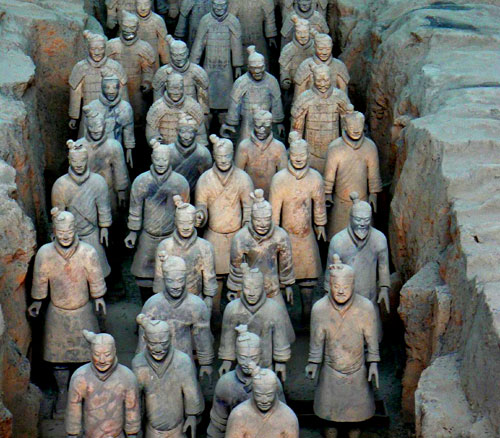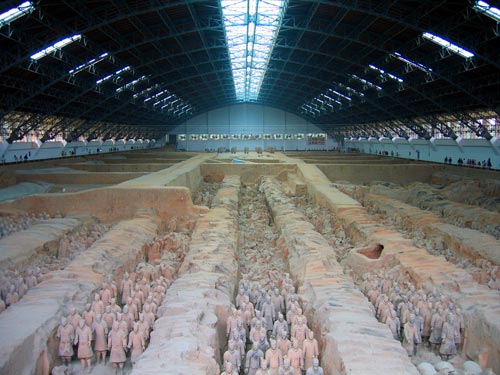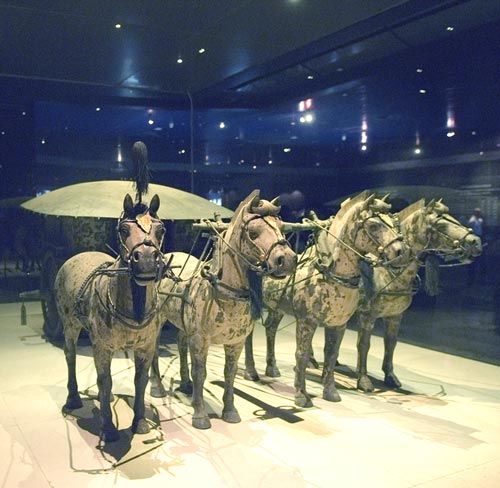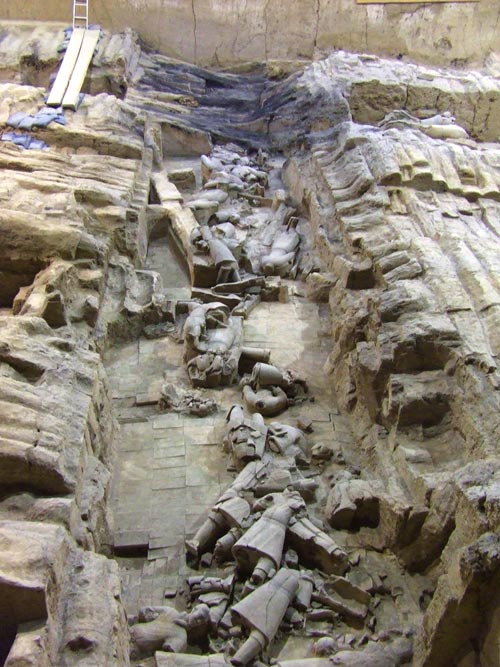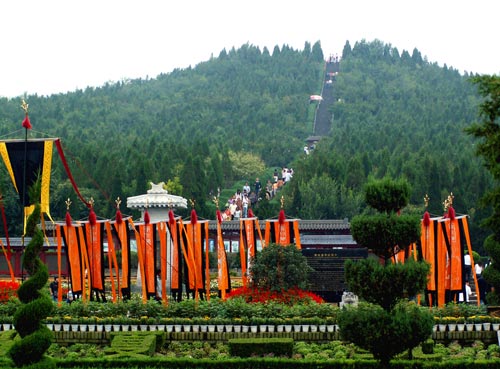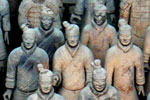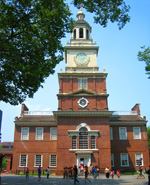Terracotta Warriors ( Mausoleum of the First Qin Emperor )
Terracotta Warriors Pit 1 , originally uploaded by Ben Burkland/Carolyn Cook.
Emperor Qin's Terra-cotta army pits are the large attendant pits, located about 1 mile (1.5 kilometers) east of the Emperor QinShihuang's mausoleum, symbolizing the main defending force that guarded the capital before Emperor Qin died. The Terracotta soldier pits were never mentioned in the historical records until Pit 1 was discovered in March 1974 by local Chinese farmers while drilling a well. Then archaeologists began the explorations and excavations of the Terra cotta Army. On October 1, 1979 Emperor Qin's Terra-Cotta Warriors and Horses Museum was opened to the public about 22 miles (35 kilometers) East of Xian, China. The Terracotta Warriors and Horses Museum receives over 2,000,000 Chinese and Foreign Tourists a year with an annual ticket income of around 150 million yuan (2005).
Pit 1, the largest pit that has been found. Terracotta Army Pit 1, originally uploaded by gds.Facts about Terra Cotta Army - Pit 1
Pit 1 is the largest of the three pits. It measures 755 feet (230 meters) long from east to west, 203 feet (62 meters) wide from north to south, covering an area of 153,493 square feet (14,260 square meters). Up to now, about 2,000 clay warriors and horses, 20 wooden chariots have been unearthed with in an area of 43,056 square feet (4,000 square meters). It's assumed that more than 6,000 terracota warriors and horses, and 50 chariots were buried in Pit 1.
Making the Terra Cotta Warriors
All pottery warriors and horses were made using local clay, then baked in the kiln. After firing the figures were completed with painted detail. The Qin Terracotta Warriors and Horses were made in life-size.
The Construction of Pit 1
Pit 1 is a subterranean earth and wood structure. Eleven corridors, divided by ten earth-rammed partition walls, are paved with pottery bricks on which the teracotta figures were placed. The earth walls sustained wood roof that was composed of huge and strong rafters. The roof was covered with layers of fiber mats on which fine soil was filled.
The Mausoleum of the First Qin Emperor was included as a World Heritage Site on the basis of Cultural Criteria I, III, IV and VI.
Criterion I. Because of their exceptional technical and artistic qualities, the terracotta warriors and horses, and the funerary carts in bronze are major works in the history of Chinese sculpture prior to the reign of the Han dynasty.
Criterion III. The army of statues bears unique testimony to the military organization in China at the time of the Warring Kingdoms (475-221 B.C.) and that of the short-lived Empire of a Thousand Generations (221-210 B.C.). The direct testimony of the objects found in situ (lances, swords, axes, halberds, bows, arrows, etc.) is evident. The documentary value of a group of hyperrealistic sculptures where no detail has been neglected from the uniforms of the warriors, their arms, to even the horses' halters- is enormous. Furthermore, the information to be gleaned from the statues concerning the craft and techniques of potters and bronze-workers is immeasurable.
Terracotta Warriors in unrestored condition, originally uploaded by rpoll.Criterion IV. The mausoleum of Qin Shi Huang is the largest preserved one in China. It is a unique architectural ensemble whose layout echoes the urban plan of the capital, Xianyang, with the imperial palace enclosed by the walls of the city, themselves encircled by other walls. This capital of the Qin (to which succeeded on the present site of Xian the capitals of the Han, Sui, Tang, Ming and Qing dynasties) is a microcosm of the Zhongguo (Middle Country) that Qin Shi Huang wanted both to unify (he imposed throughout the land a single system of writing, money, weights and measures) and to protect from the barbarians that could arrive from any direction (the army which watches over the dead emperor faces outward from the tomb).
Criterion VI. The mausoleum of Qin Shi Huang is associated with an event of universal significance: the first unification of the Chinese territory by a centralized state created by an absolute monarch in 221 B.C.
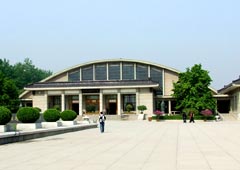 Xi’an Terracotta Warriors Museum Pit 1 , originally uploaded by rpoll.
Xi’an Terracotta Warriors Museum Pit 1 , originally uploaded by rpoll.
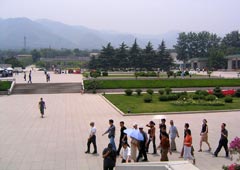 Terracotta Warriors Museum Plaza, originally uploaded by colinedwards99.
Emperor QinShihuang's Terra-cotta Museum was opened to the public in 1979. The museum consists of Pit 1, 2 and 3, which house the Terra-cotta Warriors and Terra-cotta Horses. In addition to the pits, there is another exhibition hall containing the bronze chariots and horses, as well as many other historical relics. Approximately 8,000 Terra cotta Warriors, horses and thousands of bronze weapons were discovered here. The Terracotta Warriors Museum on the left above is the entrance to Pit 1. The top two large pictures at the top of this page are from Pit 1. The Terra cotta Warrior Museum Plaza is on the right.
Terracotta Warriors Museum Plaza, originally uploaded by colinedwards99.
Emperor QinShihuang's Terra-cotta Museum was opened to the public in 1979. The museum consists of Pit 1, 2 and 3, which house the Terra-cotta Warriors and Terra-cotta Horses. In addition to the pits, there is another exhibition hall containing the bronze chariots and horses, as well as many other historical relics. Approximately 8,000 Terra cotta Warriors, horses and thousands of bronze weapons were discovered here. The Terracotta Warriors Museum on the left above is the entrance to Pit 1. The top two large pictures at the top of this page are from Pit 1. The Terra cotta Warrior Museum Plaza is on the right.
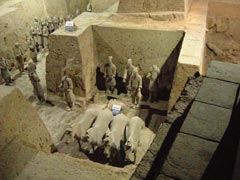 The Terracotta Warriors - Pit 3
Originally uploaded by einalem.
The Terracotta Warriors - Pit 3
Originally uploaded by einalem.
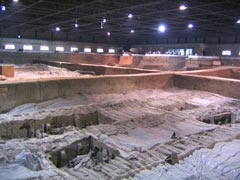 The Terracotta Warriors - Pit 2 Originally uploaded by colinedwars99.
The Terracotta Warriors - Pit 2 Originally uploaded by colinedwars99.
Facts about Pit 2
Located 66 feet (20 meters) to the north of Pit 1 at the eastern end, Pit 2 is in an "L" shape. This pit was discovered in April 1976, covering an area of 64,583 square feet (6,000 square meters). It measures 407 feet (124 meters) long from east to west, 322 feet (98 meters) wide from north to south and 16 feet (5 meters) deep. Different from Pit 1, Pit 2 consists of mixed military forces in four arrays, archers, war chariots, cavalrymen and infantrymen. The four arrays seemed to exist independently, but could be assembled immediately to constitute a complete battle formation during the war times. This reflects the unique strategy of Qin military affairs.
The excavation work of Pit 2 is still continuing. At present a large area of the remnants of the roof beams and a small part of the pottery warriors and horses are being exhibited in the pit. It is a rare chance for visitors to enjoy the archaeological digging at the site.
Information about Pit 3
Pit 3 was discovered in June 1976, located north of Pit 1 at the western end. It is 82 feet (25 meters) to the south of Pit 1 and 394 feet (120 meters) to the east of Pit 2. It is of U-Shape about 5597 square feet (520 square meters), measuring 92 feet (28 meters) long from east to west, 79 feet (24 meters) wide from north to south and about 16 feet (5 meters) deep. Investigation shows that Pit 3 has been seriously damaged over the years. Only 68 pottery figures, one chariot and 34 weapons were unearthed from this pit. Pit 3 is now know as the command center of Pit 1 and Pit 2.
An Army for the Afterlife Qin Shi Huang Di's Masouleum
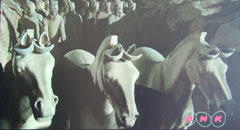 Terracotta Horses, from NHK Series Video
Terracotta Horses, from NHK Series Video
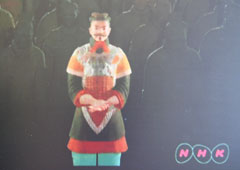 General's Colors Recreated from Pigment Traces, from NHK Series Video
Visit UNESCO Site to Play NHK video on Terracotta Warriors
General's Colors Recreated from Pigment Traces, from NHK Series Video
Visit UNESCO Site to Play NHK video on Terracotta WarriorsAn Army for the Afterlife: Qin Shi Huang Di's mausoleum
This NHK video lasts 2 minutes 50 seconds and give a brief description of Qin Shi Huang Di's Terracotta Army. The video shows an aerial view of the actual underground Masoleum shown below.
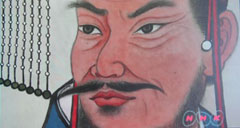 Qin Shi Huang Di Painting, from NHK Series Video
Qin Shi Huang Di Painting, from NHK Series Video
 Qin Shi Huang Di's underground Masoleum, which is 141 feet high (43 meters) image from NHK Series Video
This short video discusses Qin Shi Huang Di, China's first Emperor and the Terracotta Warriors he had built as his Army for the Afterlife. View NHK Video on Terracotta Warriors.
Qin Shi Huang Di's underground Masoleum, which is 141 feet high (43 meters) image from NHK Series Video
This short video discusses Qin Shi Huang Di, China's first Emperor and the Terracotta Warriors he had built as his Army for the Afterlife. View NHK Video on Terracotta Warriors.
Brief History of Qin Shi Huang Di Mausoleum
Qin Shi Huang Di's Mausoleum Mound. This is the stairway up the mound. The Terracotta Warriors and Horses Museum is about 1 mile from here. Emperor Qin’s Mausoleum Mound, originally uploaded by wit.
Qin Shi Huang Di - First Emperor of China
The first emperor of China, Qin Shi Huang -Ying Zheng- (221-210 B.C.) arranged for his burial place long before his accession to the seat of supreme power. When he became king of Qin in 247 B.C., Zheng had his geomancers choose a favorable site at the foot of Mount Li. Work was commenced and was carried out more energetically with each new political and military success over his rivals Han, Zhao, Wei, Chu, Yan and Qi. Following the proclamation of the Empire of Ten Thousand Generations in 221, work at the burial place took on extraordinary dimensions. According to Sima Qian (circa 145-95 B.C.), the great memorialist who collected all the extant oral traditions of his day, 700,000 workers from every province of the Empire toiled unceasingly until the death of the Emperor in 210 in order to construct a subterranean city within a gigantic mound. The place was a veritable scale model of the palace, the empire and the world. Its treasures were safeguarded by automatically triggered weapons designed to thwart tomb robbers. After Qin Shi Huang's death, the principal craftmen of the hypogeum were walled up upon order by the second emperor, as a precaution that they not betray their secrets.
The Mausoleum of Qin Shi Huang Di
The mausoleum of Qin Shi Huang, located 22 miles (35 kilometers) from Xian, is still landmarked by an imposing mound 141 feet (43 meters) high. The interior is built within a first square enclosure, with doors in the middle of each of the four walls corresponding to the four cardinal points. This in turn is surrounded by a second rectangular enclosure running north-south. The mausoleum's superstructures have disappeared and there remains only a wooded knoll resembling a truncated pyramid on a 350m square base. Its historic significance being obvious, the site, was classified by decree as early as 1961 .
Finding the Terra Cotta Warriors
In 1974, a chance discovery made the mausoleum of Qin Shi Huang one of the most famous archaeological sites in the world. While sinking a well 1 mile (1.5 km) from the exterior eastern wall of the mausoleum's inner room, three peasants from the small village of Yangeun-west came upon a pit in which there were life-size terracotta statues of warriors. Excavations were immediately begun. Pit l contained a veritable army of 1,087 warriors (provisional 1985 figure), the infantry and cavalry corps standing in battle formation with archers protecting the flanks. Today it is estimated that there are a potential 6,000 statues of warriors and horses in that one pit alone, which has floored galleries 755 feet (230m) long. It is now entirely enclosed by the site museum inaugurated on 1 October 1979. Two other pits were discovered just north of Pit l and were found to contain similar items - 1,500 warriors, carts and horses in Pit 2; 68 officers and dignitaries, a cart with four horses in Pit 3. These pits were provisionally backfilled and the objects extracted from them displayed in exhibition rooms flanking the north and south ends of the great hall of the site museum. Other finds were made on the western slope of the mound. These included notably two half-life-size molten bronze carriages. According to current estimates, the statue army of the Qin Shi Huang Mausoleum must have represented the exact number of the imperial guards, i.e. more than 8,000 warriors and horses. Discoveries have revealed the dimensions of the mausoleum, and the site constitutes one of the most fabulous archaeological reserves in the world.
